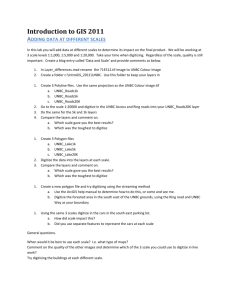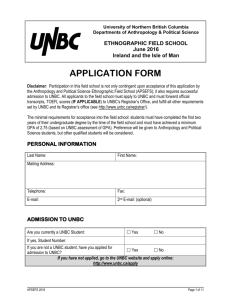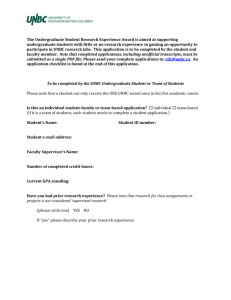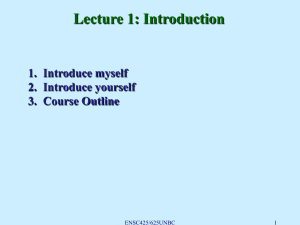ppt
advertisement
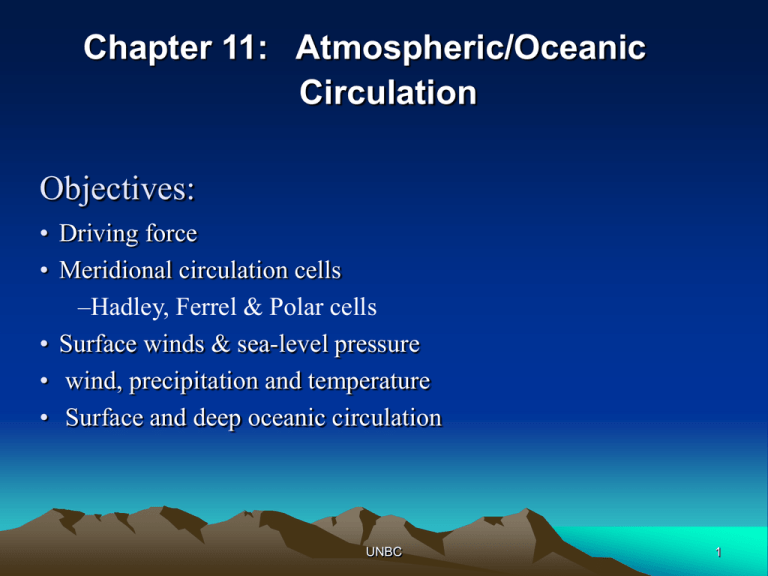
Chapter 11: Atmospheric/Oceanic Circulation Objectives: • Driving force • Meridional circulation cells –Hadley, Ferrel & Polar cells • Surface winds & sea-level pressure • wind, precipitation and temperature • Surface and deep oceanic circulation UNBC 1 • Atmospheric circulation is the large-scale movement of air. • The large-scale structure of the atmospheric circulation varies from year to year, but the basic structure remains fairly constant. • Individual weather systems – mid-latitude weather may occur "randomly“. However, the average of these systems - the climate - is quite stable. UNBC 2 Primary High-Pressure and Low-Pressure Areas • • • • Equatorial low-pressure trough Subtropical high-pressure cells Subpolar low-pressure cells Polar high-pressure cells UNBC 3 Driving force • At higher lat., solar energy flux spreads over a wider area => less solar energy per unit area. • Earth emits outgoing radiation. •Net radiation = (incoming solar rad.) - (outgoing rad.) . UNBC 4 • Net radiation has deficit poleward of 37°, & surplus equatorward of 37°. • This means poles should keep cooling while tropics keep warming. Since this is not happening, other processes must operate to maintain net energy balance at each lat. • Atm. & oc. circulation (climate & weather) due to unequal lat. distr. of energy. Annual incoming solar rad. UNBCoutgoing terrestrial rad. Annual 5 Single Convection cell in a non-rotating Earth • Imagine the earth as a non-rotating sphere with uniform smooth surface characteristics. • the sun heats the equatorial regions much more than the polar regions. In response to this, two huge convection cells develop. UNBC 6 Farrell Cell polar Cell UNBC 7 Hardly Cell • Atmosphere is heated in the equator => Air becomes less dense and rises => Rising air creates low pressure at the equator. • Air cools as it rises because of the lapse rate => Water vapor condenses (rains) as the air cools with increasing altitude => Creates high rainfall associated with the Intertropical Convergence Zone in the tropics (ITCZ). • As air mass cools it increases in density and descends back to the surface in the subtropics (30o N and S), creating high pressure. UNBC 8 Polar cell and Farrell cell • In the pole area, the surface is much cold, especially in winter. This results in increased air density near the surface => higher pressure. The higher density and pressure lead to divergence => surface air moves towards tropic. The cold air from pole will meet the warm air from Tropic around to form “Pole Front Zone. • For mass conservation, there are aloft circulations corresponding the surface circulations, which forms two cells, called Pole cell and Farrell cell. UNBC 9 A idealized pattern of surface wind without rotation of the earth UNBC 10 The pattern of surface wind with the rotation of Earth UNBC 11 – The three-celled model vs. reality: the bottom line • Hadley cells are close approximations of real world • Ferrel and polar cells do not approximate the real world • Model is unrepresentative of flow aloft • Continents and topographic irregularities cause model oversimplification UNBC 12 A) Idealized winds generated by pressure gradient and Coriolis Force. B) Actual wind patterns owing to land mass distribution.. UNBC 13 • Sfc. winds converg. towards Eq., deflected by Coriolis => Easterlies (NE & SE Trades) • The sfc. winds converg. at the ITCZ (Intertropical Convergence Zone). – Rising air => clouds. – region called “doldrums” by sailors. • Rising air at ITCZ spreads poleward, sinking at 30° (high p belts = subtropical highs). – region called “horse latitudes” (horses thrown overboard or eaten by sailors). UNBC 14 • High p at poles => sfc.air flows equatorward; Deflected by Coriolis => Polar Easterlies converg. to the Subpolar Low (low p at 60°) • Coriolis deflects air flowing from subtropical high to subpolar low => Westerlies • Polar cell 60°-90°, Ferrel cell 30°60° – Where mild air from Ferrel cell meets cold air from polar cell => polar front • Hadley & polar cells are thermally driven, but Ferrel cell is a thermally indirect cell. UNBC 15 • Horse Latitudes Around 30°N we see a region of subsiding (sinking) air. Sinking air is typically dry and free of substantial precipitation. Many of the major desert regions of the northern hemisphere are found near 30° latitude. E.g., Sahara, Middle East, SW United States. • Doldrums Located near the equator, the doldrums are where the trade winds meet and where the pressure gradient decreases creating very little winds. That's why sailors find it difficult to cross the equator and why weather systems in the one hemisphere rarely cross into the other hemisphere. The doldrums are also called the intertropical convergence zone (ITCZ). UNBC 16 Surface winds & sea-level pressure (SLP) January UNBC 17 Surface winds & sea-level pressure (SLP) July UNBC 18 • N.Hem.: Bermuda (Azores) High, Pacific High, Icelandic Low, Aleutian Low. • July: Bermuda High & Pacific High stronger & further north. Icelandic Low & Aleutian Low weaken & shift northward. ITCZ shifts northward • Jan.: Highs over continents in N.Hem., lows over contin. in S. Hem. (monsoon effect). • July: Lows over continents in N.Hem., highs over contin. in S. Hem. UNBC 19 The Sahel reflects seasonal migration of the ITCZ UNBC 20 Shifts in the ITCZ affect the Sahel UNBC 21 • Hadley, Ferrell, and Polar cells are major players in global heat transport of the south-north. They are called Latitudinal circulation, caused by latitudinal difference of incident solar radiation. Longitudinal circulation, on the other hand, comes about because water has a higher specific heat capacity than land and thereby absorbs and releases heat less readily than land UNBC 22 The Upper Troposphere • Two important points: – Pressure decreases more rapidly in cold air – Temperature in lower troposphere decreases poleward • Creates upper level pressure gradients UNBC 23 e a n d H e i g h t UNBC 24 • 500 mb heights decrease poleward • pressure gradient stronger during the winter • 500 mb heights are higher in the summer than in the winter UNBC 25 Westerly Winds in the Upper Atmosphere • the existence of the upper level pressure gradient air is being pushed toward poles • Coriolis effect deflects upper air Westerlies dominate upper troposphere • Strongest during winter • explains why storms move eastward, flight times UNBC 26 The Polar Front and Jet Streams • • • • • • Gradual change in temperature with latitude does not always occur Steep temperature gradients exist between cold and warm air masses polar front - marks area of contact, steep pressure gradient polar jet stream polar jet stream - fast stream of air in upper troposphere above the polar front stronger in winter, affect daily weather patterns Low latitudes subtropical jet stream UNBC 27 Rossby Waves • Rossby waves - largest of these planetary wave patterns • seasonal change – fewer, more well-developed waves in winter, with stronger winds • instrumental in meridional transport of energy and storm development UNBC 28 The Walker circulation is caused by the pressure gradient force that results from a high pressure system over the eastern pacific ocean, and a low pressure system over Indonesia. When the Walker circulation weakens or reverses, an El Niño results. The Southern Oscillation Index (SOI) is calculated from the monthly or seasonal fluctuations in the air pressure difference between Tahiti and Darwin. UNBC 29 UNBC 30 • The Walker circulation, which spans almost half the circumference of Earth, pushes the Pacific Ocean’s trade winds from east to west, generates massive rains near Indonesia, and nourishes marine life across the equatorial Pacific and off the South American coast. Changes in the circulation, which varies in tandem with El Niño and La Niña events, can have far-reaching effects. UNBC 31 Jet streams • Jet streams: air currents thousands of km long, hundreds of km wide, a few km thick (centred near tropopause). • Max speed > 200 km/hr. • Polar jet stream near polar front, separating cold air from mild air. Jet stream turning south => cold air moves south. UNBC 32 • So there is sinking air around 30 degree, which forms divergence region on surface and convergence region aloft. The convergence between cold air with warm air can cause a great temperature gradient in this region, and further causing a large gradient in pressure => speeding the air flow => cause the jet. UNBC 33 • Subtropical jet stream at ~30° • Jet streams meander, polar jet may merge with subtropical jet. • Polar jet may also branch into 2. UNBC 34 2 mechanisms for jet streams 1) Where polar cell meets Ferrel cell, or Ferrel cell meets Hadley, airs of different T meet => large T gradient => large p gradient => geostrophic winds. mv 1r1 mv 2 r2 2) As air moves from low to high lat., its circular orbit shrinks. => orbiting speed incr. (conservation of angular momentum; e.g. spinning skater moves arms towards body). UNBC 35 Sea breeze • Daytime: land warms more than sea => rising air & low p on land. Air flows from sea to land. UNBC 36 Land breeze • Night: Land cools more than sea. => Sinking air & high p over land. Air flows from land to sea. UNBC 37 Valley breeze & mountain breeze • Daytime: At same elevation, air on mountain slope heated more than air over valley => low p over mountain slope => air flows upslope from valley (valley breeze). • Night: Air on mountain slope cooled more than air over valley => mountain breeze. UNBC 38 Chinook wind • Chinook: warm, dry wind on eastern slope of Rockies. • Western slope: condensation => release of latent heat. Moisture lost from precip. • Descending wind on eastern slope => warming from compression. UNBC 39 Monsoons • largest synoptic scale winds on Earth • A seasonal reversal of wind • Asian monsoon which is characterized by dry (wet), offshore (onshore) flow conditions during cool (warm) months • Orographic lifting leads to high precipitation totals UNBC 40 Monsoons • Winter: continents cool more than oc. => sinking air & high p over continent • Summer: continents warm more than oc. => rising air & low p over continent • Most prominent with the massive Asian land mass. UNBC 41 Winter monsoon UNBC 42 Summer monsoon UNBC 43 Meridional cells & precip. • Northward shift of cells during summer, & southward shift during winter => precip. changes. UNBC 44 Oceanic Circulation UNBC 45 Temperature T • Vertical profile: – Solar radiation absorbed within 100m of sea surface. – Wind => surface mixed layer of 50200m, (T is nearly uniform). – Thermocline occurs between 2001000m depth: T decr. rapidly with depth. – Below thermocline, T decr. very slowly to 0-3oC at oc. bottom. UNBC Mixing layer thermocline-> 46 • Thermocline: The thermocline is the transition layer between the mixed layer at the surface and the deep water layer. In the thermocline, the temperature decreases rapidly from the mixed layer temperature to the much colder deep water temperature. • The mixed layer and the deep water layer are relatively uniform in temperature, while the thermocline represents the transition zone between the two. UNBC 47 Vertical temperature section in Atlantic South North UNBC 48 UNBC 49 Surface currents • Gyres: Large horizontal circulation cells. UNBC 50 UNBC 51 • The trade wind brings water flowing from the east to west. After the water arrives at the west boundary, the water is deflected northward. The water then come under the influence of westerly wind, which cause the water to flow eastward. When the water arrives at the eastern boundary, some of water goes to polar region, and some flows to equator. The water that flows to the equator come back under the influence of the trade wind, and are blown westward again. This forms a large circulation in subtropical region => subtropical gyre (clockwise in NH). UNBC 52 Ocean’s role in global heat transport • Oc. transports almost as much heat poleward as atm.: Oc. dominates at low lat., atm. dominates at mid-high lat. UNBC 53 • Heat capacity: amount of energy needed to raise temp. of a unit mass by 1°C. • Water has a high heat capacity: – Temp. range over land many times that over oc., as heat cap. of water much larger than that of soils/rocks. – Oc. heat capacity ~1600 times of atm. UNBC 54 • Oc. has strong moderating effect on climate, e.g. coastal regions milder than inland. • Large heat capacity => difficult to change oc. => oc. has long "memory" & major role in climate time scale, where atm. becomes "slave" to oc. UNBC 55 • Wind stress: Often we are much more interested in the force of the wind, or the work done by the wind. The horizontal force of the wind on the sea surface is called the surface wind stress. The force per unit area that wind exerts on the surface of the ocean. UNBC 56 • • • Coriolis Force = Wind stress Wind stress = tangential force on a unit area of oc. surface When the surface water moves, it drags along the water just below it, making the water just below it moving. The current has a speed of V0 to the northeast. In general, the surface current is 45° to the right of the wind when looking downwind in the northern hemisphere. The current is 45° to the left of the wind in the southern hemisphere. Below the surface, the velocity decays exponentially with depth: UNBC 57 UNBC 58 • Nansen (1890s) observ. iceberg moving 20-40o to right of wind. • Ekman (1905) sol’n. has surface current at 45o to right of wind in N.Hem. (to the left in S.Hem.) (Coriolis effect). UNBC 59 • On surface, the moving is at just 45 degree to the right of wind; at subsurface, a thin layer below surface, the moving is at an angle which is larger than 45 degree to the right; With the increase of depth, the angle become lager and lager until the current moves just opposite to surface current at some depth (around 100m). This is called Ekman Spiral. • Ekman layer: from surface to some depth where the current moves at the direction opposite to the surface current. UNBC 60 Ekman Mass Transports • Flow in the Ekman layer carries mass. For many reasons we may want to know the total mass transported in the layer, called as Ekman mass transport. The transport is perpendicular to the wind stress, and to the right of the wind in the northern hemisphere. UNBC 61 Application of Ekman Theory UNBC 62 Upwelling & downwelling • Wind blowing alongshore can generate offshore Ekman transp. => upwelling Onshore Ekman transp. => downwelling UNBC 63 • Along Equator, Easterlies => Ekman transport away from Eq. => strong upwelling along Eq. UNBC 64 • In N.Hem., surface current spirals to the right with incr. depth. Observ. wind driven layer (Ekman layer) is ~10-100m • The depth-integrated mass tranport (Ekman transport) is at 90o to right of wind in N.Hem. i.e. wind balances Coriolis. Wind Coriolis Ekman transport UNBC 65 Geostrophic currents Tilt in sea level (SL) => pressure gradient => pressure (p) force. When p force is balanced by the Coriolis force => geostrophic current. SL Coriolis current Low p p force UNBC High p 66 Gradual buildup of a geostrophic current: current Low p High p p force Coriolis force Coriolis force Low p High p UNBC p force 67 N.Hem.: low lat. easterlies, mid lat. westerlies => converging Ekman transport & high sea level (SL) at ~30°N => geostrophic currents. Ekman transp. 45°N Coriolis force p force geostrosphic current H 30°N 15°N High SL UNBC H 68 • Pressure gradient from SL tilt disappears by ~1000m depth => geostrophic current only in top 1000m. UNBC 69 3 forces in upper ocean: • wind stress, pressure gradient, Coriolis • In Ekman layer (top 100m) mainly Coriolis balancing wind stress. • 100-1000m: mainly Coriolis balancing pressure gradient => geostrophic current. UNBC 70 Deep Water Circulation Thermohaline circulation UNBC 71 • Originally the deep water is formed in North Atlantic, near Greenland, iceland and Norwegian sea (NADW). The NADW sinks into bottom and then further moves southward. The NAWD will move to Antarctic region and merge with ABW (Antarctic bottom water), and move northward to arrive at the North Pacific. Meanwhile, the surface current near the western Pacific ocean moves southward in the form of gyre, and further cross Indian ocean and back to Atlantic ocean to replace water there sinking into bottom. • So, the thermohaline circulation includes a deep ocean circulation from the North Atlantic Ocean to the North Pacific to bring deep water (salty and cold) into Pacific Ocean; and a surface current from the North Pacific to North Atlantic ocean. Both circulations act to make the water mass conservation. UNBC 72 • The effect of Thermohaline circulation on climate (1) THC transports heat from the south to North to warm the North Atlantic and Europe. (2) adjust the low latitude climate too by transporting surplus heat UNBC 73 Change in annual temperature 30 years after a collapse of the thermohaline circulation UNBC 74 What are the consequences of an El Nino? * increased rainfall in the southern US and the west coast of South America * drought in Western Pacific and India * collapse of fisheries off western coast of South America UNBC 75 El Nino – Southern Oscillation (ENSO) What is El Nino? Warming of sea surface temperatures (SSTs) in the central and eastern tropical Pacific What is the Southern Oscillation? Changes in the pressure pattern and trade wind strength (direction) in the tropical Pacific Together El Nino (EN) and the Southern Oscillation (SO) = ENSO Act as a major disruption of the ocean-atmosphere system in the tropical Pacific UNBC 76 UNBC 77 SSTs anomalies during an ENSO event UNBC 78 UNBC 79 NASA, 2003 UNBC 80


